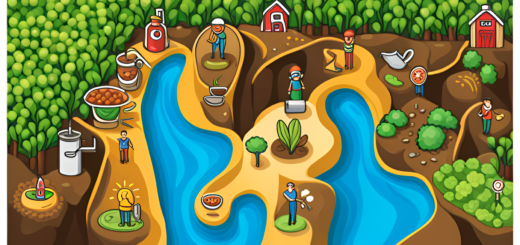Preserving Australia’s Land: The Importance of Soil Conservation

When it comes to agriculture, soil conservation is a top priority in Australia. As a country with a rich agricultural history, preserving the health and quality of our soil is crucial for both the environment and the economy. In this article, we’ll take a closer look at soil conservation, its importance in Australian agriculture, and the various techniques and government initiatives aimed at promoting it. We’ll also discuss the role of soil testing in maintaining healthy, productive soil for generations to come.
Understanding Soil Conservation
Soil conservation refers to the process of maintaining and improving the quality of soil to ensure its long-term sustainability and productivity. This is especially important in agriculture, where healthy soil is a key factor in producing high-quality crops. Soil conservation helps to prevent soil erosion, increase water retention, and maintain essential nutrients and organic matter in the soil, all of which are vital for successful crop production.
By practicing soil conservation, farmers can not only improve the quality of their crops but also contribute to the overall health of the environment. For example, healthy soil can act as a natural carbon sink, helping to reduce greenhouse gas emissions. Furthermore, soil conservation can help preserve natural habitats and ecosystems, which in turn support biodiversity.
The importance of soil conservation has been recognised in the rise of organic farming in Australia. By adopting sustainable farming practices, organic farmers are playing a key role in preserving our nation’s soil health and ensuring a future for agriculture in Australia.
Soil Erosion in Australia
Soil erosion is a major concern in Australia, posing a significant threat to the health and productivity of our agricultural land. The main causes of soil erosion in Australia include deforestation, overgrazing, and improper land management practices. These factors can lead to the loss of valuable topsoil, reduced soil fertility, and increased salinity, all of which can have severe consequences for both the environment and agriculture.
The effects of soil erosion on the environment are far-reaching. In addition to the loss of fertile soil, erosion can also contribute to water pollution, as sediment and nutrients are washed into waterways. This can result in the degradation of aquatic habitats and the loss of biodiversity. Furthermore, soil erosion can exacerbate the effects of climate change by reducing the soil’s ability to store carbon, thus contributing to greenhouse gas emissions.
For agriculture, the impact of soil erosion can be devastating. The loss of fertile topsoil can lead to reduced crop yields and increased input costs, as farmers must rely on more fertilisers and other chemical inputs to compensate for the loss of nutrients. This not only places a financial burden on farmers but can also lead to further environmental degradation, as excessive use of fertilisers can contribute to water pollution and soil degradation.
Soil Conservation Techniques
Fortunately, there are many soil conservation techniques that can be employed by farmers to help protect and maintain the health of their soil. These include:
- Contour farming: By ploughing and planting along the natural contours of the land, farmers can help to slow down water runoff, reducing erosion and increasing water infiltration into the soil.
- Terracing: The construction of terraces on sloping land can help to prevent soil erosion by reducing the speed of water runoff and increasing the amount of water that can be absorbed by the soil.
- Crop rotation: This involves changing the types of crops planted in a particular field from year to year. Crop rotation is not only an effective method for managing soil fertility and reducing soil erosion, but it also has numerous other benefits for agriculture, such as reducing the risk of pests and diseases. You can learn more about crop rotation in Australian agriculture in our previous article.
- Cover crops: Planting cover crops between the main cash crops can help to protect the soil from erosion, improve soil fertility, and suppress weeds. Cover crops can also enhance soil biodiversity and promote the growth of beneficial microorganisms.
- Conservation tillage: This refers to a range of reduced tillage practices that aim to minimise soil disturbance and maintain a protective layer of plant residue on the soil surface. Conservation tillage can help to reduce soil erosion, improve soil structure, and conserve soil moisture.
By adopting these soil conservation techniques, farmers can significantly reduce the risk of soil erosion and maintain the long-term productivity of their land. Furthermore, these practices can also contribute to the overall health of the environment by promoting biodiversity, reducing greenhouse gas emissions, and protecting water quality.
Government Initiatives for Soil Conservation
The Australian government recognises the importance of soil conservation and has implemented various programs to support farmers in their efforts to protect and improve the health of their soil. These programs aim to provide funding, resources, and technical support to farmers who are implementing soil conservation practices on their land.
One such initiative is the National Landcare Programme, which promotes sustainable land management and provides funding to farmers for projects that improve soil health, reduce erosion, and increase biodiversity. The programme encourages community involvement in soil conservation efforts, emphasising the importance of collaboration between farmers, landowners, and local communities in maintaining Australia’s precious soil resources.
In addition to government programs, there are numerous resources available to farmers seeking to implement soil conservation techniques on their land. These include educational materials and workshops, as well as access to expert advice and support from organisations dedicated to promoting soil conservation in Australia. By taking advantage of these resources, farmers can not only improve the health and productivity of their soil but also contribute to the overall well-being of our environment and agricultural industry.
Importance of Soil Testing
Soil testing is an essential tool for farmers looking to implement effective soil conservation practices. By regularly testing their soil, farmers can gain valuable insights into its health, fertility, and nutrient levels, allowing them to make informed decisions about their land management practices. Some of the key benefits of soil testing include:
- Identifying nutrient deficiencies or imbalances, enabling farmers to apply the appropriate fertilisers and amendments to improve soil fertility.
- Monitoring soil pH and salinity, which can have a significant impact on crop growth and yield.
- Determining the presence of soil-borne diseases or pests, allowing farmers to implement targeted integrated pest management strategies for Australian farmers.
There are several types of soil tests that can be conducted, including chemical analysis, biological assessments, and physical evaluations.
By conducting regular soil tests, farmers can not only optimise their land management practices but also ensure that their soil remains healthy and productive for years to come. Furthermore, soil testing can help to identify potential environmental issues, such as nutrient leaching or soil degradation, allowing farmers to address these problems before they become more serious.
Conclusion
In conclusion, soil conservation is a vital aspect of Australian agriculture that plays a critical role in maintaining the health and productivity of our land. By understanding the causes and consequences of soil erosion, adopting effective soil conservation techniques, and participating in government initiatives aimed at promoting sustainable land management, farmers can help to preserve Australia’s precious soil resources for future generations.
Furthermore, by regularly testing their soil and making informed decisions about their land management practices, farmers can ensure that their soil remains healthy and productive. As individuals and communities, we all have a responsibility to take action in preserving Australia’s land, ensuring a sustainable future for our environment and agricultural industry.



